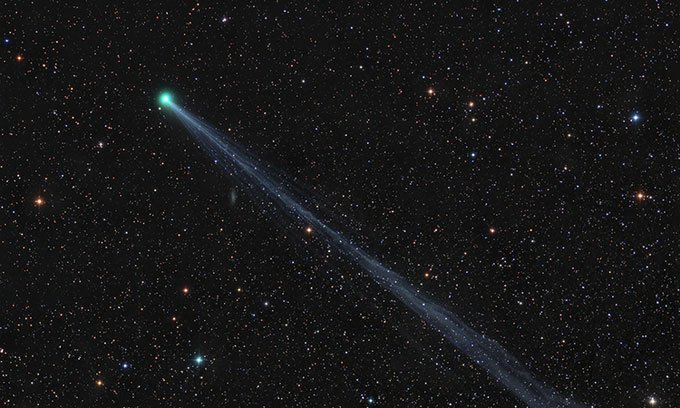Green comets are about to fly over the Earth
Comet C / 2020 F8 (SWAN) will reach the Earth closest in mid-May before rushing towards the Sun and decaying.
C / 2020 F8 is a relatively small green-colored object, first detected last month by amateur astronomer Michael Mattiazzo based on observations from the SWAN device on the Solar Observatory and Heliosphere. As of May 5, the comet is only 98 million km from Earth and flies at a speed of 137,000 km / h.

Comet C / 2020 F8 taken on May 2. (Photo: Damian Peach).
According to calculations by NASA and the European Space Agency (ESA), C / 2020 F8 will reach the Earth closest on 13/5 at a distance of 85 million km with brightness visible to the naked eye. A few weeks later, the object reached its perihelion (closest to the Sun) at a distance of 64 million km from the star.
As the comet moves closer to the Sun, it will decay with increasing radiation. This process releases gas, forming two tails behind the comet and creating a temporary atmosphere - called the coma - around the nucleus of the object.
While the gas tail is formed by the action of charged particles from the solar wind on the gas molecules released by comets, the dust tail is the result of the interaction between photon particles emitted from the Sun and dust. coming up from coma, the team explained.
"Right now, the 2020 C8 F8 can be seen through binoculars and telescopes in the southern hemisphere , " said Rick Fienberg, a spokesman for the American Astronomical Society. The light intensity of the comet is increasing and in theory, it can be observed with the naked eye as it approaches the Earth.
However, the ability to see comets depends on many factors such as darkness, clear sky conditions or the size of the object. Artificial light pollution, combined with the full moon, could hinder the opportunity to contemplate C / 2020 F8 next week.
- The twin comets fly closest to Earth in 250 years
- The interstellar comet is about to fly closest to Earth
- The brightest blue comet in the sky rushes towards Earth
- Twin comets fly closest to Earth within 250 years
- Comets cause huge fire rain on Earth
- Comets bring life materials to Earth
- If the comet ever destroyed the dinosaurs that hit the Sun, what would happen?
- Comet 'century' approaches the Earth
- Small planets, comets near Earth in 2013
- When the comet is causing
- The Philae robot sends signals from comets to Earth
- Extremely special comets will appear in 2013
- Comet: Assassin kills the dinosaurs
- In 2014, comets attacked Mars
 Van Allen's belt and evidence that the Apollo 11 mission to the Moon was myth
Van Allen's belt and evidence that the Apollo 11 mission to the Moon was myth The levels of civilization in the universe (Kardashev scale)
The levels of civilization in the universe (Kardashev scale) Today Mars, the sun and the Earth are aligned
Today Mars, the sun and the Earth are aligned The Amazon owner announced a secret plan to build a space base for thousands of people
The Amazon owner announced a secret plan to build a space base for thousands of people